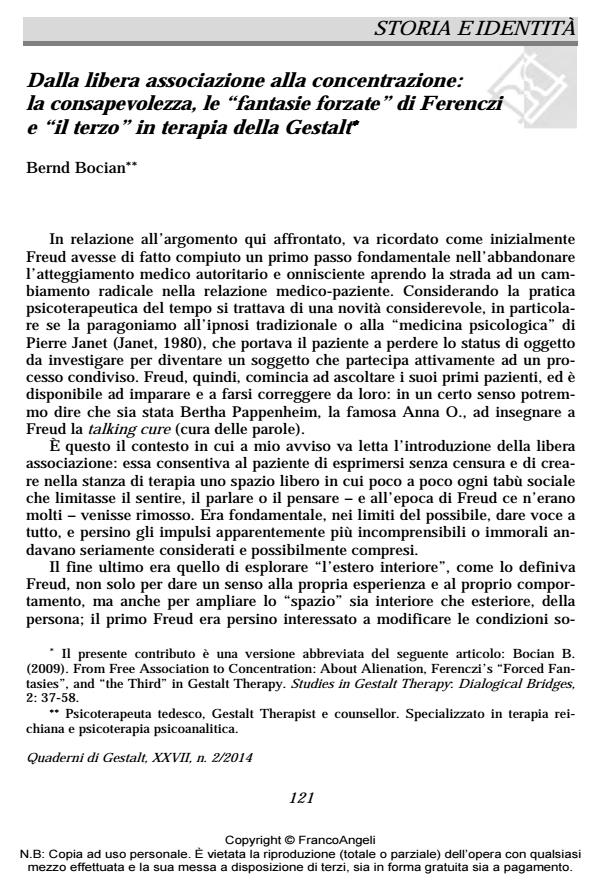From free association to concentration: awareness, Ferenczi’s "forced fantasies" and "the third" in Gestalt therapy
Journal title QUADERNI DI GESTALT
Author/s Bernd Bocian
Publishing Year 2015 Issue 2014/2 Language Italian
Pages 15 P. 121-135 File size 245 KB
DOI 10.3280/GEST2014-002008
DOI is like a bar code for intellectual property: to have more infomation
click here
Below, you can see the article first page
If you want to buy this article in PDF format, you can do it, following the instructions to buy download credits

FrancoAngeli is member of Publishers International Linking Association, Inc (PILA), a not-for-profit association which run the CrossRef service enabling links to and from online scholarly content.
This paper describes Perls’s revision of Freud’s technique of free association as part of a tradition that started with Breuer and Freud, continued with Ferenczi and the Berlin character analysts, and then led to their student Fritz Perls. In this context, Perls’s "dramatizing techniques" that the authors calls "the third" in Gestalt therapy, are seen as further developments of Ferenczi’s work with "forced fantasies".
Keywords: Concentration, free association, gestalt therapy, character analysis, Ferenczi, history of psychotherapy.
- Antonelli G. (1997). Il mare Ferenczi. La storia, il pensiero, la tecnica di un maestro della psicoanalisi. Roma: Di Renzo.
- Bauriedl T. (1994). Auch ohne Couch – Psychoanalyse als Beziehungstheorie und ihre Anwendungen. Stuttgart: Verlag Internationale Psychoanalyse.
- Bocian B. (2009). From Free Association to Concentration: About Alienation, Ferenczi’s “Forced Fantasies”, and “the Third” in Gestalt Therapy. Studies in Gestalt Therapy: Dialogical Bridges, 3, 2: 37-58.
- Bocian B. (2012a). Fritz Perls a Berlino 1893-1933: Espressionismo, psicoanalisi, ebraismo. Milano: FrancoAngeli.
- Bocian B. (2012b) Introduzione a Fritz Perls: Resolution. Quaderni di Gestalt, XXV, 2: 87-91. DOI: 10.3280/GEST2012-00200
- Bocian B. (2013). Von der Revision der Freudschen Theorie und Methode zum Entwurf der Gestalttherapie – Grundlegendes zu einem Figur-Hintergrund-Verhältnis. In: Bocian B., Staemmler F.M., a cura di, Kontakt als erste Wirklichkeit. Zum Verhältnis von Gestalttherapie und Psychoanalyse. Bergisch-Gladbach: EHP
- Bocian B. (2015). Karl Landauer (1887-1945): Uno psicoanalista di Francoforte quasi dimenticato dalla psicoanalisi e dalla terapia della Gestalt. Psicoterapia e Scienze Umane, XLIX, 1: 37-58. DOI: 10.3280/PU2015-001002
- Böhme G. (1985). Anthropologie in pragmatischer Hinsicht. Frankfurt/M.: Suhrkamp. Breuer J., Freud S. (2003). Studi sull’Isteria e altri scritti 1886-1895. Torino: Bollati Boringhieri.
- Eissler K. (1965). Medical orthodoxy and the future of psychoanalysis. New York: International Universities Press.
- Ferenczi S. (1931). Le analisi infantili sugli adulti. In: Fondamenti di Psicoanalisi. Vol. 3. Rimini: Guaraldi, 1974
- Ferenczi S. (1973). Fondamenti di psicoanalisi. Volume II: Prassi. Rimini: Guaraldi.
- Ferenczi S. (1974a). Fondamenti di psicoanalisi. Volume III: Ulteriori contributi (1908-1933). Rimini: Guaraldi.
- Ferenczi S. (1974b.). Fondamenti di psicoanalisi. Volume IV: Articoli commemorativi, recensioni e presentazioni. Rimini: Guaraldi.
- Ferenczi S. (1985). Bausteine zur Psychoanalyse. Band 4. Frankfurt a.M.: Ullstein.
- Ferenczi S., Rank O. (1924-1986). The development of psycho-analysis. Madison, CT: International Universities Press.
- Freud S. (2001). La morale sessuale civile e il nervosismo moderno. In: Il motto di spirito e altri scritti 1905-1908. Torino: Bollati Boringhieri.
- Fromm E. (1980). Grandezza e limiti del pensiero di Freud. Milano: Mondadori.
- Fromm E. (1994). The art of listening. New York: Continuum (trad. it.: L’arte di ascoltare. Milano: Mondadori, 1995).
- Goldstein K. (1939). The Organism – A holistic approach to biology derived from pathological data in man. New York: American Book Company.
- Heigl-Evers A., Ott J. (1994). Die psychoanalytisch-interaktionelle Methode – Theorie und Praxis. Göttingen: Vandenhoeck & Ruprecht.
- Horkheimer M., Adorno Th.W. (2010). Dialettica dell’Illuminismo. Torino: Enaudi.
- Horney K. (1987). Final lectures. New York, London: Norton (trad. it.: Le ultime lezioni. Milano: Astrolabio, 1988).
- Janet P. (1980). La médecine psychologique – réédité. Paris: Masson.
- Landauer K. (1991). Theorie der Affekte und andere Schriften zur Ich – Organisation. Frankfurt a.M.: Fischer.
- Lorenzer A. (1993). Intimität und soziales Leid. Archäologie der Psychoanalyse. Frankfurt a.M.: Suhrkamp.
- Macaluso M.A. (2013). Concentrazione gestaltica, mindfulness e processi integrativi del cervello. In: Cavalieri P.A., cura di, Psicoterapia della Gestalt e neuroscienze. Dall’isomorfismo alla simulazione incarnata. Milano: FrancoAngeli, 119-135.
- Moser T. (1990). Das zerstrittene Selbst – Berichte, Aufsätze, Rezensionen. Frankfurt a.M.: Suhrkamp.
- Perls F. (1995). L’Io, la fame, l’aggressività. Milano: FrancoAngeli.
- Perls F.S., Hefferline R.F., Goodman P. (1997). Teoria e pratica della terapia della Gestalt. Vitalità e accrescimento della personalità umana. Roma: Astrolabio.
- Perls F.S., Clements C.C. (1968). Acting out vs. acting through. Voices 4, 4: 66-73.
- Pohlen M., Bautz-Holzherr M. (1995). Psychoanalyse – Das Ende einer Deutungsmacht. Hamburg: Rowohlt.
- Reich W. (1925). The impulsive character. In: Reich W., a cura di, Early writings, Vol. 1. New York: Farrar, Straus & Giroux, 1975.
- Reich W. (1942). The discovery of the orgone – Vol. 1: The function of orgasm – Sexeconomic problems of biological energy. New York: Orgone Institute Press.
- Reich W. (1973). Analisi del carattere. Milano: SugarCo Edizioni.
- Waldvogel B. (1992). Psychoanalyse und Gestaltpsychologie. Historische und theoretische Berührungspunkte. Stuttgart-Bad Cannstatt: Frommann-Holboog.
Bernd Bocian, Dalla libera associazione alla concentrazione: la consapevolezza, le "fantasie forzate" di Ferenczi e "il terzo" in terapia della Gestalt in "QUADERNI DI GESTALT" 2/2014, pp 121-135, DOI: 10.3280/GEST2014-002008